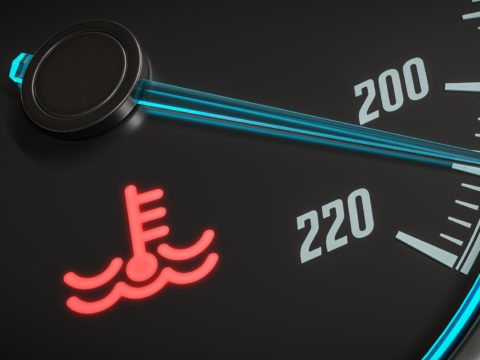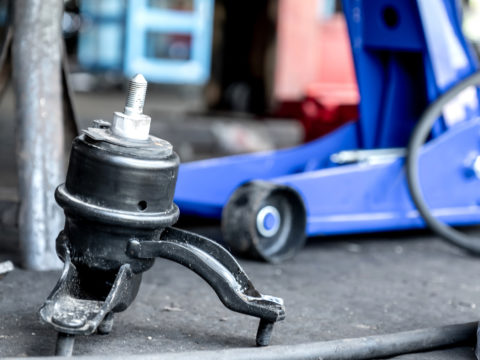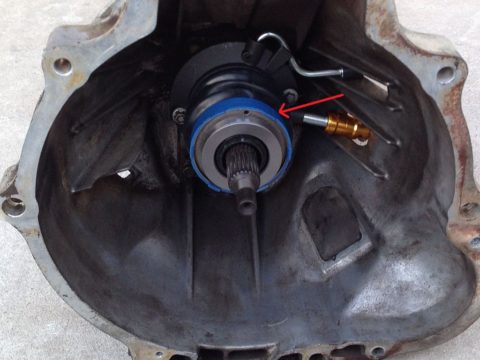The clutch and transmission have two crucial bearing types; the clutch release bearing and the pilot bearings.
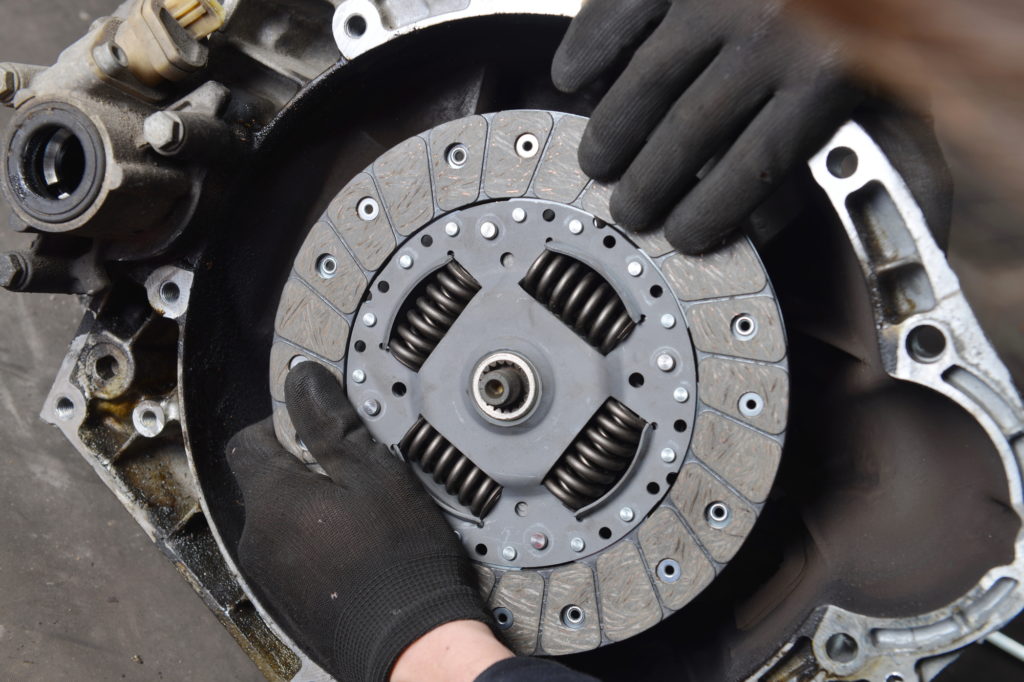
When one is worn, it can be difficult to identify whether the release bearings or the pilot bearing is the problem.
Here are the symptoms of a bad pilot bearing and how to fix it.
Contents
What Does the Pilot Bearing Do in a Car?
The pilot bearing has one primary function. It provides a low friction point of support on the end of the transmission input shaft.
Pilot bearings essentially come in three distinct forms:
- Needle bearings
- Roller bearing type or conventional ball bearings (sealed bearing type)
- Sintered bronze bushings (looks more like a bronze sleeve and are found on older cars)
Needle bearings and bronze bushings are the most common bearing type.
In manual transmissions, the engine’s crankshaft and the transmission input shaft are spinning at different speeds. It is the pilot bearing that makes this possible.
Pilot bearings will be found on most rear-wheel-drive vehicles that have a manual transmission. However, some front-wheel-drive cars with manual transmissions will have pilot bearings as well.
Where is it located?
As the pilot bearing is directly connected with the transmission input shaft, it is seated in a hole at the end of the car’s crankshaft flange.
Pilot bearing diagram
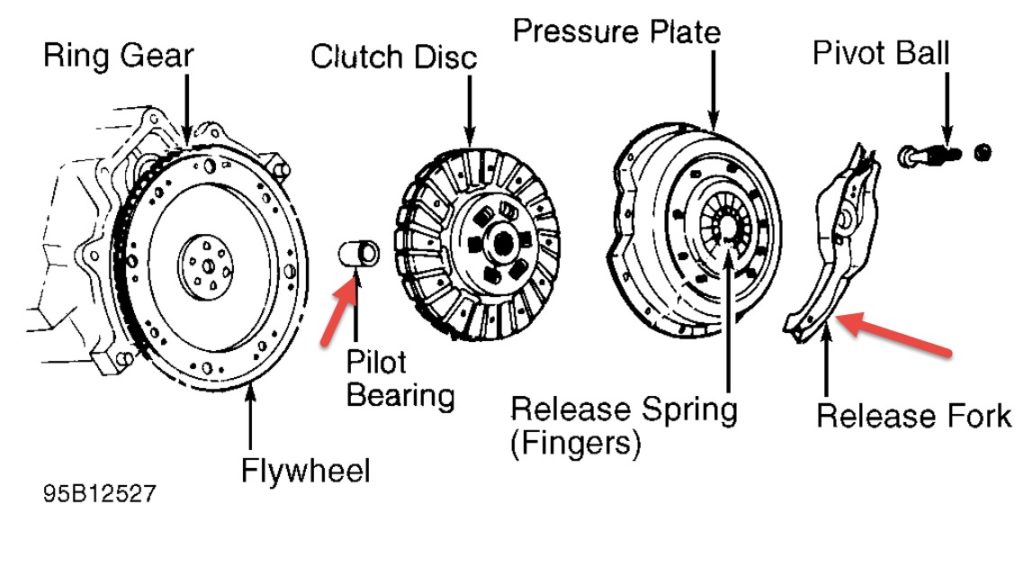
Symptoms of Pilot Bearing Failure
These are the signs and symptoms that you should pay attention to, which can indicate a faulty pilot bearing.
Noise
Listen for irregular noise when the clutch pedal is depressed. Specifically, listen for a grinding noise when the clutch pedal is being engaged. There can also be a chirping or squealing noise.
Bad clutch release bearings or pilot bearings will make a chirping or squealing noise when the clutch is engaged and the bearing makes initial contact with the pressure plate’s diaphragm.
The most noise will likely occur when shifting into reverse or first gear.
Vibrations
While a car has dozens of moving parts, all moving at their own speeds and in various directions, the car itself is not supposed to be affected. All the bearings in a car a designed for this very purpose. To disconnect the large vehicle from these numerous forms of vibrations.
When a bearing is failing, such as a faulty pilot bearing, you will then feel these vibrations. A faulty pilot bearing can result in vibrations when shifting from one gear to another.
Transmission popping
Along with allowing for free movement and eliminating vibrations, the pilot bearing also keeps the transmission’s input shaft stable and secure.
A faulty pilot bearing makes it possible for the input shaft to move around. Such movement is contrary to the precision operation of the transmission and results in the gears as well as the synchronizers moving out of alignment.
Gears and synchronizers out of alignment results in the transmission popping out of gear. This can eventually lead to the gears, input shaft, and even the entire transmission becoming completely disengaged.
No release
A bad pilot bearing can be felt in the clutch pedal. Specifically, when shifting into reverse or first gear when in a parked position. A bad pilot bearing makes it difficult for the precision operation of shifting gears.
A failing pilot bearing will create a stiff and difficult clutch pedal when trying to shift gears, and most commonly when shifting to reverse or first gear when standing still.
Total failure
If you fail to notice any of the fixed early signs of a faulty pilot bearing, you will not miss this one. Eventually, a worn pilot bearing, if not taken care of, will result in a transmission that is completely disengaged. Essentially, it will lock up due to the fact that the gears and input shaft will no longer be connected.
What Causes Pilot Bearing Failure?
All parts on a car will fail at some point. But, it is the premature or irregular reasons for failure that are problematic. A faulty pilot bearing makes for a big problem and these are the most common causes behind it.
1. Failed/failing input shaft bearing
The input shaft bearing is the very first bearing in the transmission, and thus on the transmission’s input shaft.
Essentially, the transmission’s input shaft bearing and the pilot bearing keep the input shaft aligned, stable, and secured. They are basically the same thing, with the exception that the pilot bearing and the input shaft bearing touch opposite ends.
If the input shaft bearing is going bad, the pilot bearing will be absorbing additional wear and tear and get worn out faster.
2. Bent input shaft
The input shaft must be straight to remain aligned. If it becomes bent, it will stress the bearings.
3. Input shaft defect
The transmission is built to precision. Any defect on the input shaft will affect the rotation and the bearings that hold things in place.
4. Defective input shaft bearing
Any mass-produced part has the potential to be flawed from the very beginning. A defective input shaft bearing will result in the same issues as having a defective input shaft or a bent input shaft.
How Do You Check the Pilot Bearing?
If noise is beginning to come from the transmission’s bell housing area, there’s a problem. In that area are both the clutch release bearing and the pilot bearings. The issue could be with either bearing.
The best way to diagnose the condition of the pilot bearing is with a road test. Only by operating the transmission and shifting gears can you differentiate between the clutch release bearing and the pilot bearing.
While driving the car, listen for the above-mentioned noise when the clutch pedal is depressed to the floor or noise in general when the transmission is in gear.
Then, release the clutch pedal with the transmission in first gear. If there is noise in this situation, that is a definite sign of worn release bearings or worn pilot bearings.
To determine whether the problem is a worn clutch release bearing or the pilot bearings, push the clutch pedal to the floor and shift into Neutral.
If the noise continues, this means it is the clutch release bearing that has gone bad.
If the noise terminates, that means the problem is the pilot bearing.
How to Remove and Fix a Bad Pilot Bearing
Tools and equipment needed
To properly remove the pilot bearing, you need a pilot bearing removal tool called a pilot bearing puller.
These steps begin after you have acquired the proper removal tool and taken the entire transmission out of the car:
Step 1
Before beginning, you should put the new pilot bearing in the freezer. It needs to sit there for at least half an hour to shrink in size. You can also do this at the beginning of Step 4.
Having backed off the jam nut completely, insert the removal tool into the middle of the pilot bearing until the tip reaches the rear of the damaged pilot bearing. Extend the fingers of the removal tool by turning the handle clockwise. This will secure the tool in the balance wheel for the pulling process.
Step 2
With a secure hold on the removal tool, tighten the jam nut with a wrench. This should cause a small pop to occur. That means the damaged pilot bearing is moving from the camshaft. Continue this movement of pulling the pilot bearing outward until it is completely disengaged and out.
Step 3
Inspect the bad pilot bearing and compare it with the new pilot bearing to ensure it is the correct match. Both the inside and outside diameters must be exact. If the new pilot bearing is the correct part, move on to Step 4.
Step 4
Put the new bearing in the freezer for about half an hour to shrink if you have not done so already. If you have, take it out of the freezer now.
Gently seat the flat side of the new pilot bearing into the camshaft flange. Use a rubber mallet to gently tap it into place.
Lubricate the new pilot bearing with either axle bearing or silicone-based grease. Ensure you do not over-lubricate the bearing or get grease on the clutch disc or the flywheel. Lubrication will increase friction on soft metal-type bushings.
Put everything back together and install the transmission into the car properly.
Can You Drive With a Bad Pilot Bearing?
The short answer is that you shouldn’t. Driving with a damaged pilot bearing can result in a damaged transmission input shaft, and potentially needing to replace the entire transmission.
However, from a purely technical standpoint, you may be able to drive for a little while with a damaged pilot bearing.


